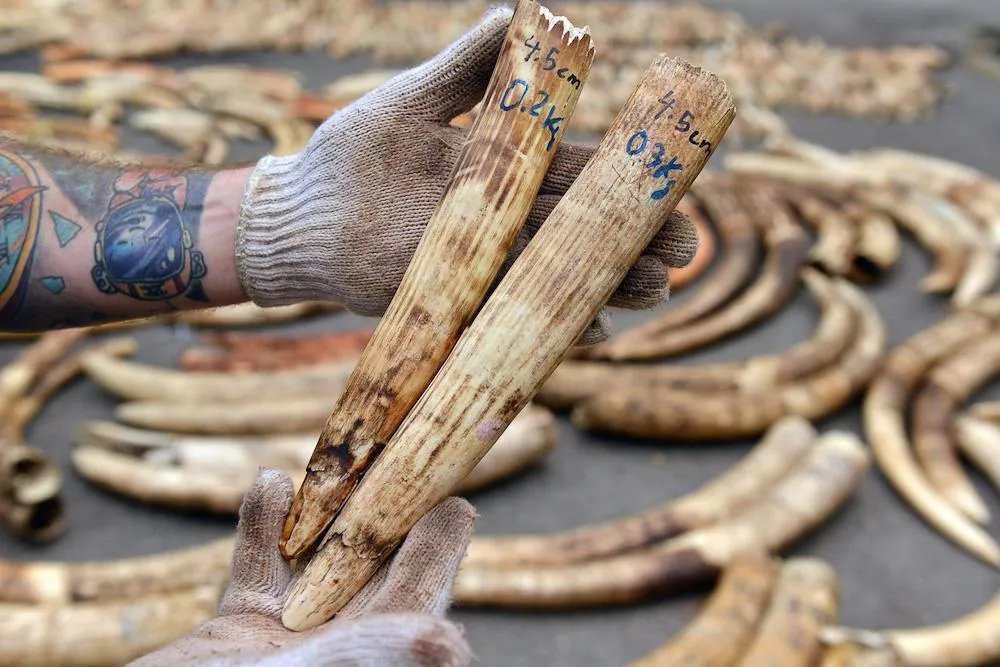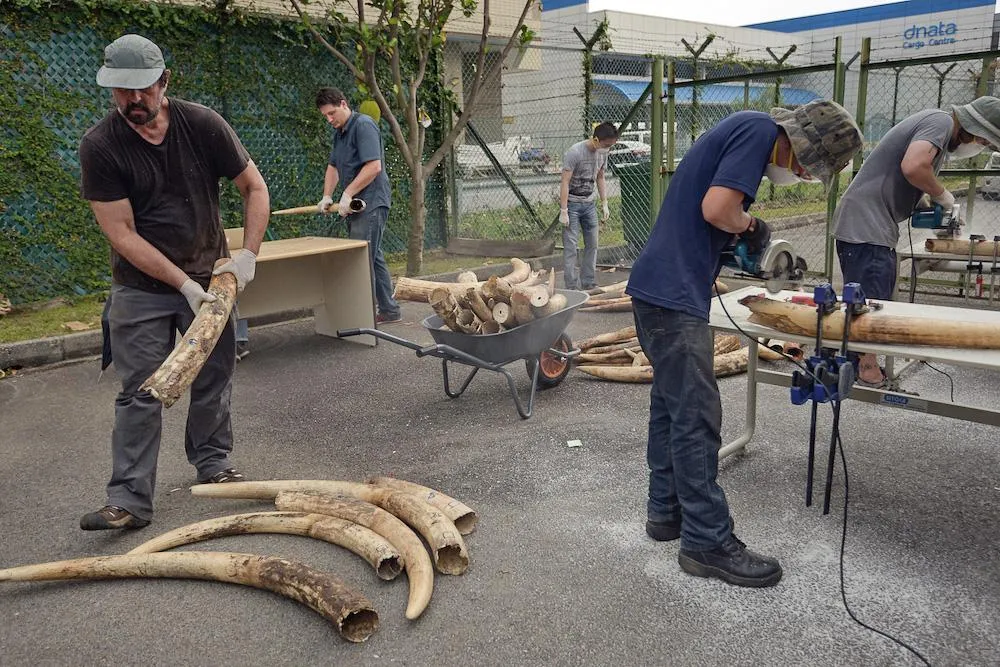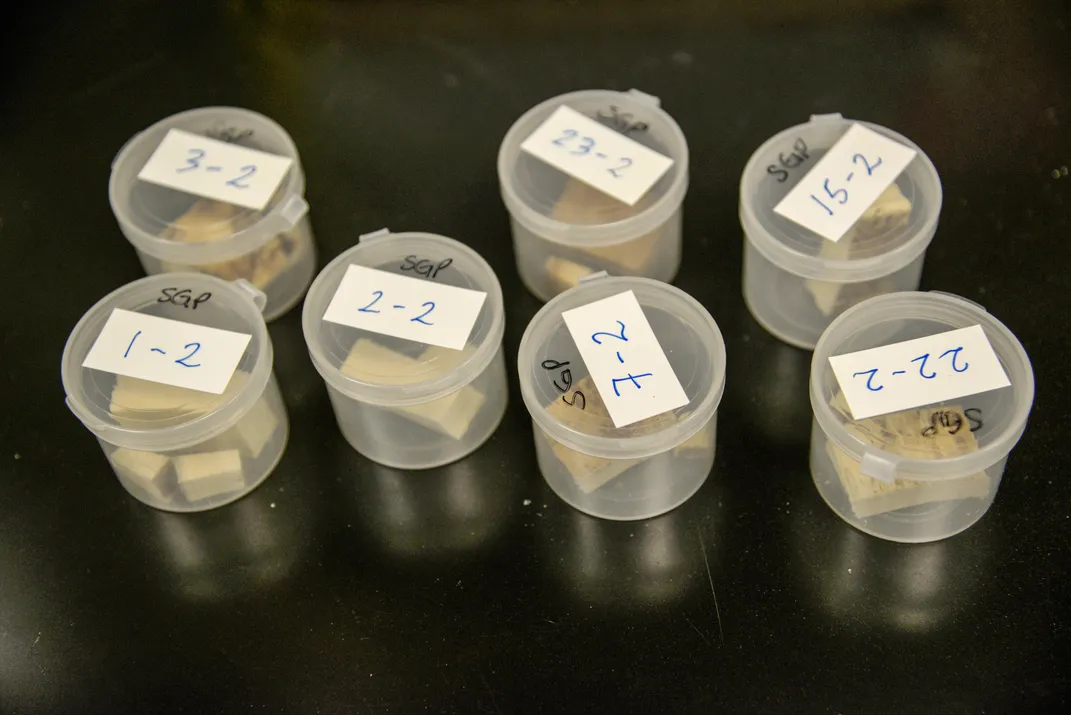There’s a New Tool in the Fight Against Elephant Poaching
An American biologist wields an innovative weapon against the illegal trade in African ivory
/https://tf-cmsv2-smithsonianmag-media.s3.amazonaws.com/filer/9a/77/9a7753f8-e6c5-4bbe-8a54-6e9c52941b4d/janfeb2017_e01_colwasserpoachinglab.jpg)
When Sam Wasser, a conservation biologist at the University of Washington, flew into Singapore on October 26, 2015, one of the first things he did was borrow a car and drive to a hardware store. He bought two circular saws, some F clamps and a wheelbarrow. Then he headed to an old aviary inside the city’s port.
Authorities, acting on an anonymous tip, had seized 80 tea sacks that had been shipped from Mombasa, Kenya. The tea had been replaced with elephant tusks—1,700 of them, which together weighed more than five tons. On his first day at the site, Wasser measured and weighed each tusk individually. The weather was hot—almost 90 degrees—and muggy, and within a half-hour Wasser was drenched in sweat.
He logged the weights on an Excel spreadsheet and recorded any unique markings on the tusks. (Several had large black x’s, which presumably identified them as belonging to a certain dealer or poacher.) The next day, his team tried to match pairs of tusks—he didn’t want to sample the same elephant twice—and clustered them into groups. Finally, he put on a mask and goggles, unboxed the circular saws and started cutting out pieces of ivory about the size of a matchbox.
At one point, he gestured at the hundreds of tusks—beige and brown and rust-colored—laid out on the ground. His T-shirt was dripping wet and covered in a fine layer of ivory powder. “There are periods throughout the process where it really gets to me,” he said. “Especially that there is such a large number of tusks weighing less than one pound—too small even to sell. I mean look at all this. It’s insane.” He estimated that the seizure represented at least a thousand dead elephants.
Wasser, who is 63, has black hair, a graying beard and, under his eyes, the deep, dark circles of the chronically sleep-deprived. Two decades ago, he began working on a geographic map of elephant genetics using DNA extracted from dung. Populations from different regions carry different mutations, and Wasser’s map shows where each mutation can be found. When he analyzes a piece of ivory, he can find its specific mutation and match it up with his dung map, locating the spot where the animal was slaughtered. It’s like having a high-level informant inside the world of wildlife crime.
Over the past several years, as elephant poaching has reached crisis proportions, Wasser has found himself ever more in demand. His work on elephants is financed, in part, by the family foundation of Microsoft cofounder Paul G. Allen. (Wasser has also received funding from the Smithsonian Institution, as well as from the U.S. Department of State and the U.N. Office on Drugs and Crime.) His sampling efforts have shown that most illegal ivory is coming from just two “hotspots.” This, in turn, has provided a powerful tool for law enforcement officials deciding where to focus their resources. And it has helped lead to some high-level arrests, including one of an ivory dealer from Togo nicknamed the Boss and a Chinese woman who’d been dubbed the Queen of Ivory.
“I can’t say enough good about his research and what he’s done,” Susan Snyder, director of the Office of Anti-Crime Programs at the State Department, told me.
“I think Sam deserves a Nobel Prize,” said Bill Clark, a former chairman of Interpol’s Wildlife Crimes Group.
**********
“This is killer whale,” Wasser said, pulling a large plastic test tube out of a freezer. He was back in his lab in Seattle, though only briefly, because he was about to head off to Geneva for a convention on illegal wildlife trafficking. At the bottom of the tube sat a half-inch of what looked like frozen mud, but was, in fact, orca ordure. It had been collected with the aid of a specially trained dog named Tucker, who can sniff out floating whale droppings from a mile away.
“We’ve got Hawaiian monk seal in here,” Wasser went on, indicating another tube. “Polar bear. Pacific pocket mouse. Sage grouse.”
“Here’s caribou,” he said. He proffered a visitor a baggie filled with brown pellets.
Wasser has been called the “guru of doo-doo,” and it’s a title he wears with pride. In the 1980s, he pioneered the use of scat as a tool for studying wild animals by extracting hormones from their droppings. Then, in the 1990s, he became one of the first researchers to show that feces could be a source of DNA. “Scat is the most accessible animal product in the world,” Wasser told me. “And it contains a huge amount of information, from the DNA of the animal that left it, to the DNA of all the things the animal was eating, to the microbiome in its gut, to its reproductive hormones, to its stress and nutritional hormones, to toxins.”
Because scat contains so much information—and because so much is churned out daily—Wasser has been able to resolve questions that probably otherwise would have been unanswerable. When, for example, orcas off the San Juan Islands stopped having babies, no one was sure why. Some marine biologists blamed stress caused by boatfuls of whale-watching tourists; others proposed the cause was toxins, like PCBs, which accumulate up the food chain. By analyzing the orca poop from the open-bowed deck of a Grady-White powerboat, Wasser and his graduate students were able to determine that the orca whales were conceiving. The trouble was they were miscarrying 60 percent of their fetuses. Wasser’s team found the reason: a decline in the whales’ favorite food, Chinook salmon. As the orcas grew hungrier, their fat released toxins that ended their pregnancies. (The discovery has not yet led to any policy changes, to Wasser’s regret.)
Wasser began enlisting dogs in his research after he attended a conference on bears and heard a talk about hunting with hounds. He found a program run in a state prison that taught dogs how to sniff out narcotics, and the sergeant in charge invited him to attend two rounds of training. “They start the dogs on marijuana because it smells so much,” Wasser explained. “When they moved to heroin, we moved to poop.”
In one study, Wasser used scat-sniffing dogs to track five large animals—giant armadillos, giant anteaters, maned wolves, pumas and jaguars—through Brazil’s Cerrado, a once-vast savanna that’s largely been cut up into ranches. The study found that jaguars and giant armadillos were particularly sensitive to human disturbance and avoided agricultural land. Maned wolves, pumas and anteaters, meanwhile, were attracted to woodland and forest vegetation remnants found within ranch lands.
He and his grad students are now working on a DNA map of pangolin poop. The only mammal wholly covered in scales, pangolins look like a cross between a badger and an artichoke. As many as 100,000 of them are poached each year, making them the world’s most heavily trafficked mammal. In parts of Asia, pangolin scales, which are made of keratin, like your fingernails, are prized for their medicinal value (though, according to science, they don’t have any). Also pangolin is prized as a delicacy, particularly in high-end restaurants in Vietnam, where the meat can sell for more than $150 a pound. To make his pangolin map, Wasser is planning to send specially trained dogs to Southeast Asia to sniff out droppings.
Wasser’s lab currently holds several freezers filled to bursting with animal feces. Next to one of them I noticed a six-inch-high figurine of Tommy Chong—of Cheech and Chong comic fame—whom Wasser, broadly speaking, resembles. Someone had outfitted the figurine with a tiny T-shirt that said “I Y Scat.”
**********
Wasser grew up in Detroit, and from early on, he knew what he wanted to do. “I was determined to be a wildlife vet in Africa,” he said. One summer in college, he got a job with a researcher who was studying lions in Uganda. En route, Wasser stopped in Nairobi, Kenya. There he found a letter waiting for him. It said dictator Idi Amin’s soldiers had raided the researcher’s camp, stolen his truck and destroyed his data. “Don’t come,” it instructed. Wasser hadn’t traveled halfway around the world just to turn around and go home, so he found a job on a different lion study, in Kenya.
Eventually Wasser found himself working with baboons in Tanzania. Watching them, he became convinced that dominant females were forming aggressive coalitions, preventing other adult females of the troop from becoming pregnant. He theorized this was to improve their own offsprings’ chances of survival. But it was hard to confirm his idea. This difficulty led him to the work of a cancer researcher who was tracking his patients’ hormone levels by analyzing stool samples. It was Wasser’s introduction to the power of poop.
Baboons range widely, and following them Wasser covered a lot of territory. On his travels, he began to encounter gruesome relics—sometimes an elephant skull, sometimes a whole carcass. One find in particular stuck with him: a pair of teeth—the first very small and the second enormous. Probably poachers had shot a baby elephant, waited for its mother to come defend it, and then shot her. “That was a turning point for me,” Wasser said. “I was on a mission.”
Elephant ordure, Wasser knew, wasn’t hard to come by. “Often when I was working in the field, I’d just pull up a dried elephant poop and use it as a chair,” he recalled. “It was everywhere.” Meanwhile, a single gram of scat might contain millions of sloughed-off cells, each with a copy of its producer’s DNA. Wasser started to collect samples on his own. Then he put out a call to biologists and game wardens all around Africa: Send me your elephant scat. In this way, the groundwork was laid for his map.
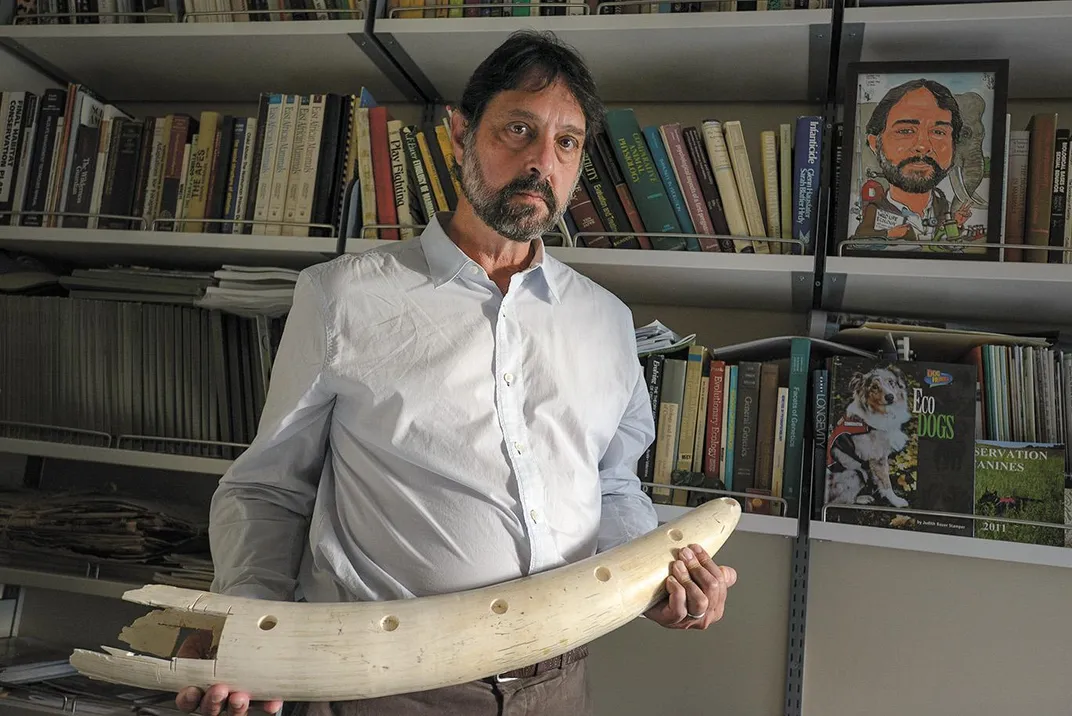
Every elephant’s DNA is similar to every other elephant’s, just as my DNA, or yours, is similar to that of every other person on earth. But different elephant groups carry different mutations. These mutations tend to build up in non-protein-coding parts of the genome—so-called “junk DNA.” These are the segments Wasser focused on. He located 16 stretches of elephant DNA where animals from different regions carry different numbers of repeating segments. (The stretches are known as microsatellites.) After ten years and thousands of analyses, Wasser reached the point where, presented with a blind sample of elephant dung, he could tell where it had been collected, within 190 miles.
The first chance Wasser got to put his map to use came in 2005. Authorities in Singapore had seized a shipment of more than seven tons of ivory. The shipment, marked “soapstone,” had traveled by ship from Malawi to South Africa, and from there had been transferred to a boat bound for Asia. It contained more than 500 whole tusks and some 40,000 small ivory cylinders. (The cylinders were clearly intended for use as hanko signature stamps, which are popular in Japan and China.) Among law enforcement officials, the assumption was that to put together a shipment this large, a dealer had to have spent years amassing ivory from many different regions. But the DNA analysis proved otherwise. All the tusks could be traced to a single population of elephants concentrated in Zambia.
“We showed the poachers were going to the same place, over and over again, and that it was likely the ivory was relatively new,” Wasser said.
The following year, in Taiwan, officials grew suspicious about two shipping containers. The containers, ostensibly filled with sisal, were supposed to be headed to the Philippines, but they seemed to keep bouncing around Asia; on the same voyage, they’d already passed through Taiwan once before. When the customs officials pried open the containers they found 1,100 elephant tusks.
Just a few days later, in Hong Kong, a resident’s complaint about a stench coming from a neighboring warehouse led to the discovery of another 400 tusks. Wasser analyzed the contents of both seizures. Again, he showed the ivory had all come from the same region, in both cases from southern Tanzania. A pattern was starting to emerge.
**********
In the mid-1970s, when Wasser first started working in Africa, roughly 1.5 million elephants roamed the continent. Over the next decade and a half, the value of ivory, which at that point still could be legally traded, skyrocketed. During 1980s, the price more than quintupled, from about $25 to $135 a pound. The elephant population, meanwhile, plummeted; by 1989, it had fallen to around 600,000, and experts warned that Africa’s elephants were headed toward extinction.
To reverse this gruesome trend, parties to the Convention on International Trade in Endangered Species of Wild Fauna and Flora, or CITES, enacted what amounted to a ban on international sales of African ivory. The ban went into effect in 1990, and for several years it seemed to be working. Poaching eased, and in some parts of Africa, elephant populations started to recover. But in 2006, just after Wasser began putting his map to use, the killing started up again. Growing demand in Asia lofted prices to new levels. By 2012, black market ivory was fetching $1,000 a pound in Beijing. That year alone, an estimated 22,000 African elephants were poached. Clearly deaths were outpacing births, and, once again, experts warned of a crisis.
“The question is: Do you want your children to grow up in a world without elephants?” is how Andrew Dobson, an ecologist at Princeton, put it. The number of elephants in Africa may now be about 400,000, which means that if current trends continue, the animals could be wiped out within two decades.
For Wasser, the new wave of poaching translated into a flood of samples. The seizures in Taiwan and Hong Kong were followed by seizures in, among other places, the Philippines, Thailand and Malaysia. By 2015, he’d analyzed 28 major shipments, totaling more than 62.5 tons of ivory. The results were depressingly consistent. Each shipment had a clear geographical signature, which indicated that all, or at least most, of the tusks had been amassed from a single region. And the same signatures kept showing up over and over. The vast bulk of the ivory came from elephants in two regions. The first is an area known as the Tridom, which includes parts of northeastern Gabon, the northwestern Republic of Congo and southeastern Cameroon. The second region includes parts of Tanzania, primarily the area where Wasser used to study baboons, as well as parts of northern Mozambique and southern Kenya.
Right around the time I visited him in Seattle, the Great Elephant Census released its preliminary results. Researchers had conducted aerial surveys across Africa, collectively flying some 288,000 miles. The census lined up with Wasser’s findings: Between 2009 and 2016 the number of elephants in Tanzania fell by more than half, from 109,051 to 42,871.
“I kept expecting it to change,” Wasser told me. “I thought, Oh my God, I’m looking at all the seizures, and every single one of them is coming from the same place.”
Two years ago, Wasser and his colleagues noticed that more than half the tusks in a given seizure were loners—the other tusk from that animal wasn’t in the same shipment. Using DNA analysis, they were able to find the match for these tusks, often sent several months earlier or later, but always going through the same port. “In doing that, we’ve been able to find major trafficking networks and track their sizes,” Wasser said.
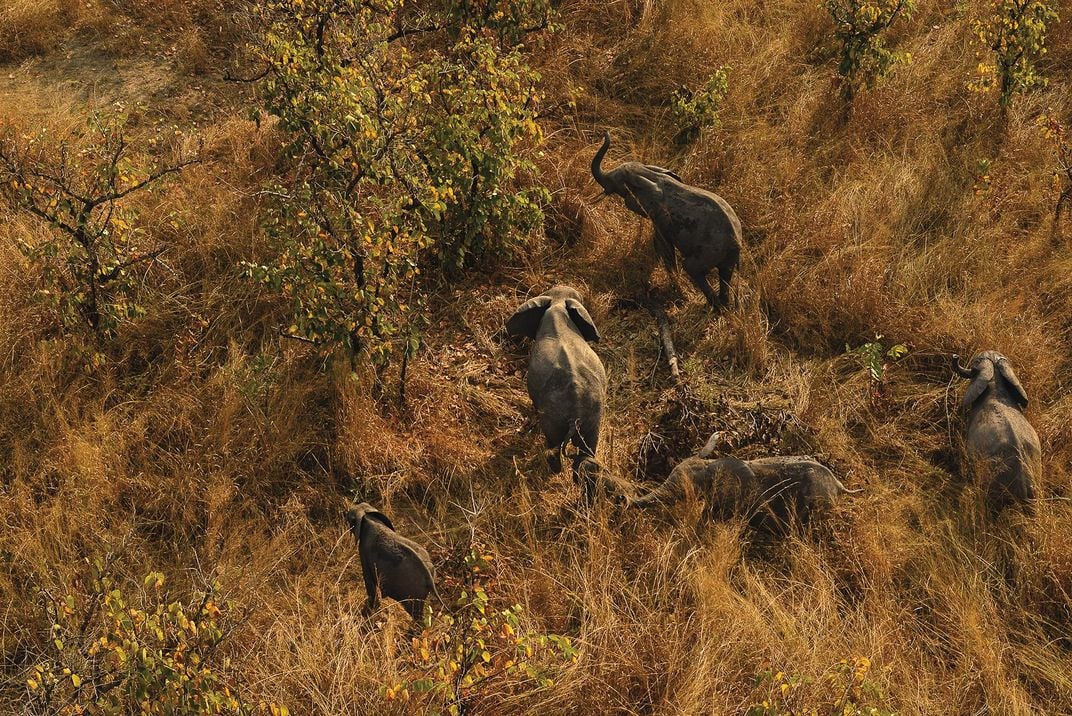
A picture is now emerging. Major dealers or their middle-men supply poachers with weapons and purchase orders: Send us this much ivory by this date. Poachers hunt in a concentrated area, filling the order bit by bit: two tusks on a motorcycle, ten in a car, until the quota is met. The kingpins sit removed from it all. They often try to outsmart customs officials by shipping the ivory from a neighboring country and moving it through four or five ports before it reaches its final destination. Local wildlife divisions have confirmed many of Wasser’s hypotheses. “You know you’re close to the right answer when you’re talking to officials on the ground and they say, ‘That makes sense. We’ve seen this and this is going on, and it fits perfectly with what you’re saying.’”
**********
After Wasser identified Tanzania as Africa’s largest poaching hotspot, he grew nervous about returning to the country. His fears were heightened when an official he’d worked with closely there was murdered.
In November 2015, though, things started to change. Tanzania swore in a new president, John Magufuli, who started making serious efforts to improve intelligence and crack down on traffickers. Wasser returned to Tanzania this year as part of a training program conducted with the World Customs Organization. More recently, Tanzania gave Wasser and his colleagues permission to sample the three largest shipments they’d seized. “To me, that is a monumental step forward,” he said. “They’re telling us, ‘We’re ready to work with you to solve this problem.’ A lot of this, I have to believe, is because all the international attention that’s been put on Tanzania as a result of our findings.”
Now, Wasser’s main concern is that the world’s ivory hotspot will relocate. The process will take time: Traders will need to find a new country with sufficient elephants, learn where the elephants congregate, and set up new distribution chains.
The way to squelch this process, Wasser says, is for governments to provide samples from their ivory seizures, and to do it far more quickly. “Most countries don’t turn their shipments over to us until a year, sometimes two years, after they’ve been seized,” he said. “If they gave us more recent seizures, we could identify emerging hotspots. If you wait till these places get entrenched in corruption, the network becomes far more difficult to dismantle.”
He’s hopeful that more countries will start cooperating. During the last few days of December, China—by far the world’s largest ivory market—promised to stamp out its domestic trade by the end of 2017. (The country had previously argued that ivory carvings were important parts of its heritage.) The Natural Resources Defense Council called China’s announcement “the biggest sign of hope for elephants since the current poaching crisis began.” Meanwhile, in November, Vietnam joined the growing list of countries willing to work with Wasser and his team: They decided to destroy a 2.2-ton seizure in its stockpile and let Wasser sample it. “This was a huge breakthrough,” he said. “Vietnam has seized 30 tons of ivory since 2010, and this was the first time they’ve done anything like this,” he said. He also trained local officials how to do the sampling themselves. “The more countries start seeing the kind of information this is providing, the more willing they are to provide samples from their seizures,” he said. “This battle is so hard to win. But it feels like we’re on the verge of making a really big difference.”
Related Reads
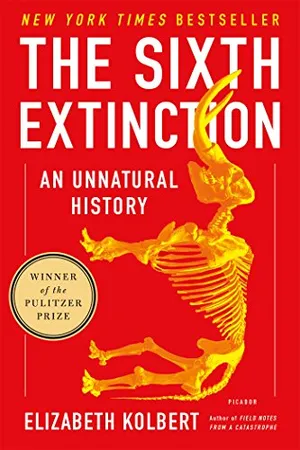
The Sixth Extinction: An Unnatural History
